On this Earth Day Colin Saxton, who cares for the many fruit trees on his property in Oregon, reflects on how trees are an integral part of caring for creation.
This post is in observance of Earth Day, April 22.
 Colin Saxton is a member of North Valley Friends in Newberg, Oregon. He and Janine are the parents of four grown children and two grandchildren. After working for Quaker organizations for most of his adult life, Colin now serves as the Everence stewardship theologian and director of church relations. He received his Master of Arts from Eastern Mennonite Seminary and his Doctorate in Ministry in leadership and spiritual formation from George Fox University/Seminary.
Colin Saxton is a member of North Valley Friends in Newberg, Oregon. He and Janine are the parents of four grown children and two grandchildren. After working for Quaker organizations for most of his adult life, Colin now serves as the Everence stewardship theologian and director of church relations. He received his Master of Arts from Eastern Mennonite Seminary and his Doctorate in Ministry in leadership and spiritual formation from George Fox University/Seminary.
______________________________
My wife, who happens to be a master gardener, is mainly responsible for the beauty and bounty of our small parcel of land. Through her careful and thoughtful approach to planning and planting, our garden space produces abundant food and flowers that we consume and share with others.
My role in this is primarily grunt labor, so I chip, dig, trim and turn the soil, as directed. I harvest most of the 17 varieties of fruits we grow, while she picks vegetables and tends the flowers. We have worked out a good partnership over the past 40+ years.
The one area I take primary responsibility for is caring for our fruit trees and bushes. Tomorrow, I will finish pruning the last of the apples. The pears, plums, elderberries, figs, raspberries, grapes and blueberries are all finished. The olive will wait until late April, around the time we celebrate Earth Day.
Trees are an integral part of Scripture. Beginning with the creation story, we see how they bear fruit, offer shade and shelter, and serve as important markers and places of worship. Trees are symbols of strength, growth and life. They are a renewable resource and an object of beauty. Trees are an essential part of the good earth we are called to tend and steward. I often think about this reality, as I am weaving my way through the branches and considering how to care for each one.
In Genesis 2:15-17, God invites Adam and Eve to partner in tending the garden. The traditional interpretation uses the words “till and keep.” A more accurate interpretation might be to “preserve and protect.” Part of my goal in caring for the trees in my yard is to enhance their productivity and ensure their longevity. Along with the fruit we eat, we are grateful for the shade they offer and the beauty they provide.
I confess my occasional discouragement over the prospect of governments agreeing to the kinds of radical changes necessary to reverse climate change. Given my age, my concern is less for myself and more for my children, grandchildren and their peers. There are days when I feel powerless when it comes to making a personal impact on climate change. Our efforts to reduce, reuse, recycle, vote, invest, lobby, eat and travel responsibly can feel like an insignificant drop in the bucket.[1] Even so, these small, but faithful, acts of stewardship are important, as we seek to honor God by caring for creation and seeking the good of others.
I find hope in caring for and planting trees. It feels like an act of resistance within a world more often bent on destruction and extraction.
While it is clear there must be widespread systemic change if we are going to mitigate the effects of climate change, experts also agree that it is essential to focus on trees. Tree planting has become a cornerstone of many environmental campaigns in recent years. The call to plant trees is everywhere, seen as a simple, cost-effective and natural technology to help reduce the impact of carbon emissions and restore natural ecosystems.
Protecting existing trees, and more specifically, forests, is crucial. In my area of the country, forest fires are decimating thousands of acres of trees each year. In our unsettled and unsettling political environment, our commitment to caring for and preserving forests is, at best, uncertain. Finding ways to focus on reforestation and restoring those places that have been degraded feels like one faithful way to preserve and protect God’s good earth, whether this is on a local, national or international basis. [2] Even looking after the few trees we have around our homes or planting new ones is a way of tending and mending God’s creation.
Next year, I will remove one of our plum trees in the backyard. It is old, and there is rot in the trunk, which makes it weak and more vulnerable to disease. It has lived a whole life, providing baskets of fruit and shade to our family and neighbors. Birds, bugs and squirrels have rested in the branches, and the rustling leaves have added something beautiful to the sights and sounds of our neighborhood. We are grateful for it.
Another tree will replace it — probably another plum. If I am fortunate, I will enjoy some of its fruit and see it grow big enough to sit under its shade. But if not, I live in the active hope that others will benefit from its beauty, fruit, shade and partnership in a healthier ecosystem and renewed creation.
[1] See “10 ways you can help fight the climate crisis.”
[2] See Restoring the World’s Forest.
 Mennonite Church USA’s Climate Justice Ministry is sponsored by Everence.
Mennonite Church USA’s Climate Justice Ministry is sponsored by Everence.
The views and opinions expressed in this blog belong to the author and are not intended to represent the views of the MC USA Executive Board or staff.

